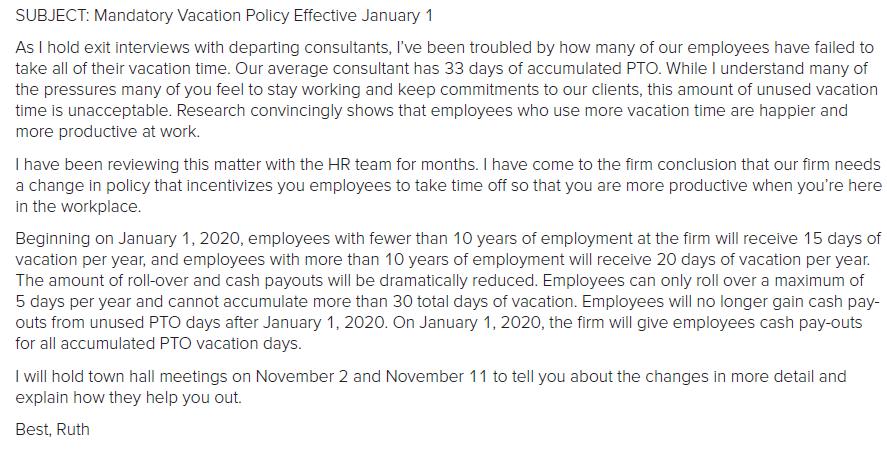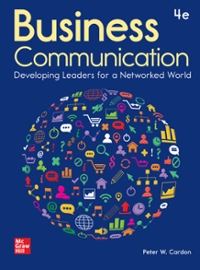Ruth Weinstein had worked at APECT Consulting for the past 18 years. Shortly after becoming president several
Question:
Ruth Weinstein had worked at APECT Consulting for the past 18 years. Shortly after becoming president several years ago, she recognized that turnover was quite high. The average consultant at the firm left after 5 to 6 years of employment. In exit interviews, departing consultants consistently talked about “being burned out”
or “needing an extended break.” Most of these departing employees still had months of unused paid vacation leave, which consistently prompted Ruth to ask, “Why didn’t you use your vacation time?”
Consultants often said they felt a pressure to avoid vacation, especially if they were early-career professionals trying to prove themselves. Some consultants said they thought they’d lose certain client accounts if they took time off.
After several years of concerns about employees overworking, Ruth decided to learn more about how vacation time might affect the business. She started examining research about vacation time.
She read a 2013 study jointly conducted by the Society for Human Resource Management and the U.S. Travel Association.7 The study showed that human resources (HR) professionals overwhelmingly thought vacation affected job performance (94%), morale (92%), wellness (92%), a positive culture (90%), productivity (90%), and retention (88%). Strong majorities of human resources professionals also thought vacation time impacted creativity (70%), employee engagement (68%), staying with the organization longer (60%), and taking fewer sick days (58%).
The current policy allows APECT employees to take paid time off (PTO) based on years of employment: 5 vacation days for employees with fewer than 3 years of employment; 10 vacation days for employees with between 3 and 5 years of employment; 15 days for employees with between 5 and 10 years of employment; and 20 days for employees with more than 10 years of employment.
As Ruth talked to her human resources team, she was told how the current roll-over policy did not provide an incentive to take vacation days during any given year. Since employees could simply roll over their vacation days at the year’s end, they could accumulate large numbers of vacation days. The human resources team told Ruth that the average consultant had accumulated 23 days of PTO. Furthermore, when consultants left the firm, they received cash payouts for unused PTO. With an average payout at approximately
$330 per accumulated PTO day, most consultants did not feel motivated to use all their vacation time.
After talking to the human resources team for roughly three months, examining vacation plan policies at competing firms, and informally talking to about a dozen consultants at the firm, Ruth and the HR team developed a new vacation policy. Beginning on January 1, 2020, employees with fewer than 10 years of employment at the firm will receive 15 days of vacation per year, and employees with more than 10 years of employment will receive 20 days of vacation per year. The amount of roll-over and cash payouts will be dramatically reduced. Employees can only roll over a maximum of 5 days per year and cannot accumulate more than 25 total days of vacation. Employees will no longer gain cash pay-outs from unused PTO days after January 1, 2020. On January 1, 2020, the firm will give employees cash pay-outs for all accumulated PTO vacation days. Ruth drafted the following announcement to employees:
Your task: Rewrite the message to improve its tone and more adequately announce the changes. Make sure to briefly mention the rationale for the changes and explain the impacts on employees.
Step by Step Answer:






